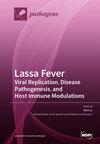Identifying New Areas of Endemicity and Risk Factors for Rickettsia conorii subsp. conorii Infection: Serosurvey in Rural Areas of Romania
IF 3.3
3区 医学
Q2 MICROBIOLOGY
引用次数: 0
Abstract
Background: Mediterranean spotted fever (MSF) is an emerging tick-borne disease caused by Rickettsia conorii subsp. conorii, primarily prevalent in Mediterranean and Southern Europe. We aimed to evaluate MSF seroprevalence and risk factors in non-endemic rural areas of Romania. Methods: We conducted a serosurvey in five counties not under MSF surveillance by testing 459 serum samples from adult volunteers for specific IgG antibodies using ELISA. Participants answered a questionnaire regarding demographics and MSF risk factors. Results: The median age of the participants was 60 years and 329 (71.7%) were female. Overall, 64 (13.9%) samples tested positive for IgG anti-R. conorii, with rates ranging from 7.1% in Sibiu to 22.4% in Hunedoara. The median age of the positive individuals was 68 years, with a significantly higher seropositivity rate of 54.7% among those over 65 years (p = 0.01). Among those positive, 53 (82.8%) owned different household animals; 24 (37.5%) had daily contact with dogs, and 27 (42.2%) with livestock; 17 (26.6%) noted tick infestations of animals, and 23 (35.9%) reported tick bites. Conclusions: This study revealed an important seroprevalence of MSF in Romanian areas considered non-endemic, indicating an expansion of its geographical range, probably due to climate change, and emphasizing the importance of enhanced surveillance and diagnostic capabilities nationwide.确定新的地方病流行区和 Conorii 亚种立克次体感染的风险因素:罗马尼亚农村地区血清调查
背景:地中海斑疹热(MSF)是一种新出现的蜱媒疾病,由康氏立克次体亚种引起,主要流行于地中海和南欧。我们的目的是评估罗马尼亚非流行农村地区的 MSF 血清流行率和风险因素。方法:我们在五个未受 MSF 监测的县进行了血清调查,使用 ELISA 方法检测了 459 份成年志愿者血清样本中的特异性 IgG 抗体。参与者回答了有关人口统计学和 MSF 风险因素的问卷。结果显示参与者的年龄中位数为 60 岁,329 人(71.7%)为女性。总体而言,64 份样本(13.9%)检测出抗 R. conorii IgG 阳性,阳性率从锡比乌的 7.1% 到胡内多阿拉的 22.4% 不等。阳性者的年龄中位数为 68 岁,65 岁以上者的血清阳性率明显较高,为 54.7%(p = 0.01)。在阳性者中,53 人(82.8%)拥有不同的家庭动物;24 人(37.5%)每天与狗接触,27 人(42.2%)与牲畜接触;17 人(26.6%)注意到动物的蜱虫侵扰,23 人(35.9%)报告被蜱虫叮咬。结论这项研究显示,在罗马尼亚被认为是非流行病的地区,MSF 的血清流行率很高,这表明可能由于气候变化,MSF 的地理分布范围有所扩大,并强调了在全国范围内加强监测和诊断能力的重要性。
本文章由计算机程序翻译,如有差异,请以英文原文为准。
求助全文
约1分钟内获得全文
求助全文
来源期刊

Pathogens
Medicine-Immunology and Allergy
CiteScore
6.40
自引率
8.10%
发文量
1285
审稿时长
17.75 days
期刊介绍:
Pathogens (ISSN 2076-0817) publishes reviews, regular research papers and short notes on all aspects of pathogens and pathogen-host interactions. There is no restriction on the length of the papers. Our aim is to encourage scientists to publish their experimental and theoretical research in as much detail as possible. Full experimental and/or methodical details must be provided for research articles.
 求助内容:
求助内容: 应助结果提醒方式:
应助结果提醒方式:


